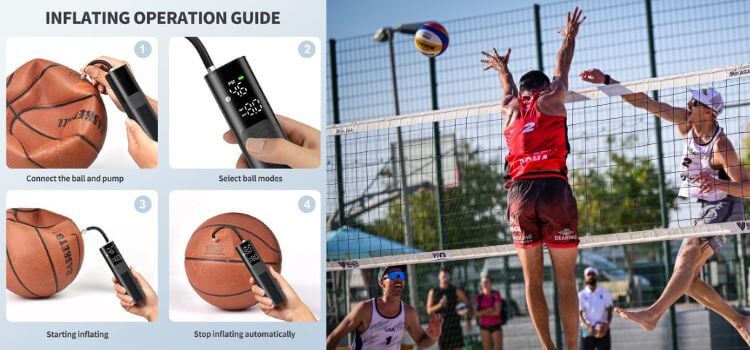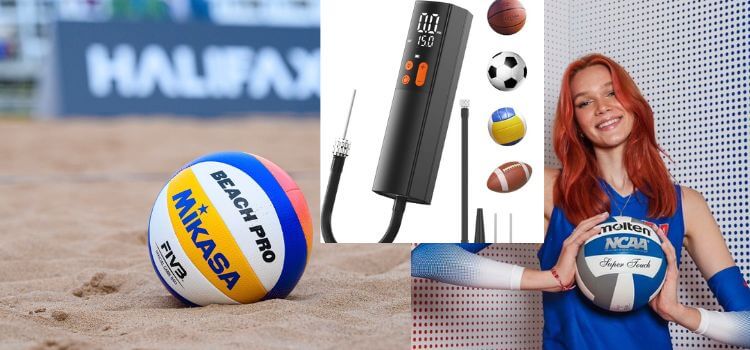As an Amazon Associate, I earn from qualifying purchases
Ever stepped onto the court with a volleyball that felt like a deflated beach ball? Or perhaps one so rock-hard it stung your hands on every bump? Proper inflation is essential for optimal volleyball performance, maximizing control, power, and preventing injuries.
This comprehensive guide equips you with all the knowledge and steps needed to inflate your volleyball perfectly, ensuring a satisfying and safe playing experience.
In this guide, we’ll delve into the step-by-step how to inflate volleyball; the process of inflating a volleyball correctly to enhance your playing experience.
How to Inflate Volleyball Inflation Pressure
Before diving into inflation techniques, let’s understand the ideal pressure range for a volleyball. According to the FIVB (Fédération Internationale de Volleyball), a volleyball should be inflated to 0.30 to 0.325 kg/cm2 (4.26 to 4.61 psi). Here’s a quick breakdown of the units:
Read More : Best Volleyball gifts for guys
Read More :
kg/cm2: kilograms per square centimeter (metric unit of pressure)
psi: pounds per square inch (unit of pressure commonly used in the US)
Tools Required for Inflating a Volleyball
Volleyball Pump
A volleyball pump is a specialized tool designed specifically for inflating volleyballs. It features a needle attachment that securely fits into the inflation valve of the ball, allowing for precise air delivery.
Read More: Volleyball Training Equipment for Hitters: Review
When selecting a volleyball pump, opt for a high-quality model with a sturdy construction to ensure durability and reliability.
Pressure Gauge
A pressure gauge is essential for accurately measuring the inflation level of your volleyball. This handheld device provides real-time pressure readings, allowing you to inflate the ball to the desired pressure range. Invest in a pressure gauge with clear markings and easy-to-read displays for hassle-free inflation monitoring. Read More : Best Used Volleyball Training Equipment
Needle Adapter
A needle adapter serves as the interface between the pump and the volleyball’s inflation valve. It ensures a secure connection between the two components, preventing air leakage during the inflation process. Choose a durable needle adapter compatible with standard volleyball pumps for seamless operation.
Read More Best Beach volleyball apparel Nike Reviewed
Optional: Valve Lubricant: A small drop of valve lubricant can ease needle insertion and prevent valve damage. However, this is not always necessary, particularly for modern volleyballs.
Why a Dedicated Volleyball Pump Matters?
While using a bike pump or air compressor might seem like a quick solution, it’s best to avoid them for several reasons:
Pressure Gauge: Most bike pumps and air compressors lack pressure gauges, making it difficult to achieve the precise inflation level. Over-inflation is a significant risk with these tools.
Read More: Best Youth Volleyball Shoes: Reviewed
Needle Size: Needles on these pumps are often too large for volleyball valves, potentially causing damage.
Inconvenience: These pumps are not designed for volleyballs, making the inflation process cumbersome and less efficient.
Inflating Your Volleyball: A Step-by-Step Guide
Now that you have the right tools, let’s inflate your volleyball to perfection!
Read More : Best Volleyball Shoes for Jumping: Reviewed
Step 1: Locate the Valve
Identify the inflation valve on your volleyball. It’s usually a small pin protruding from the surface.
Step 2 (Optional): Apply Valve Lubricant (for some valves)
A small drop of valve lubricant can ease needle insertion and prevent valve damage. However, this is not always necessary, particularly for modern volleyballs.
Read More: 11 Best Volleyball Shoes For Flat Feet: Review
Step 3: Attach the Pump Needle
Securely screw the pump needle onto the pump hose.
Step 4: Insert the Needle
Carefully push the needle straight into the valve opening. You should feel a slight resistance as it enters the valve.
Inflating with a Pressure Gauge:
If your pump has a pressure gauge, follow these steps:
Start inflating the volleyball by slowly pressing the pump handle.
Read More: 10 Best Volleyball Shoes for Middle Blocker : Reviewee
Keep an eye on the gauge and aim to reach the recommended pressure range (0.30 to 0.325 kg/cm2 or 4.26 to 4.61 psi).
Inflating by Feel (without Gauge):
If you don’t have a pressure gauge, use this method:
Inflate the ball until it feels firm but slightly yielding when squeezed with your thumb and forefinger.
A properly inflated volleyball should bounce comfortably when dropped from a reasonable height.
Step 5: Double-Check and Adjust
Once inflated, remove the needle and press your thumb firmly on the valve opening to listen for any air leaks. If you hear a hissing sound, repeat steps 4-6 to inflate further.
Step 6: Deflating (if necessary)
If you’ve over-inflated the ball, press the small pin located at the base of the valve with the tip of a pen or key to release air slowly. Be careful not to deflate it excessively.
Beyond Inflation: Maintaining Your Volleyball for Optimal Performance

Proper care goes beyond just inflation. Here are some additional tips to keep your volleyball performing at its best:
Read More: 10 Best Asics Youth Volleyball Shoes: Reviewed
Regular Cleaning: Wipe down your volleyball with a damp cloth after each use to remove dirt, sweat, and dust.
Storage: Store your volleyball in a cool, dry place away from direct sunlight. Avoid storing it inflated for extended periods.
Can I use a bike pump to inflate my volleyball?
Technically, yes, you can use a bike pump in a pinch. However, it’s strongly discouraged for several reasons:
Pressure Gauge: Most bike pumps lack pressure gauges, making it difficult to achieve the precise inflation level required for a volleyball. Over-inflation is a significant risk.
Read More 12 Best Volleyball Shoes for Wide Feet: Tested
Needle Size: Bike pump needles are often too large for volleyball valves, potentially causing damage.
Inconvenience: Bike pumps are not designed for volleyballs, making the inflation process cumbersome and less efficient.
Alternatives if You Don’t Have a Volleyball Pump
If you don’t have a dedicated volleyball pump and can’t locate one readily, here are two temporary solutions (use with caution!):
Read More: 10 Best insoles for volleyball vertical jump
Hand Pump: A small, handheld pump designed for inflating athletic balls might work in a pinch. However, these pumps typically lack pressure gauges, so be extra careful not to over-inflate.
Gas Station Air Pump: While not ideal, a gas station air pump can be used as a last resort. Extreme caution is necessary! Most gas station air pumps don’t have pressure gauges suitable for volleyballs, and over-inflation is highly likely.
Read More: 9 Best Volleyball Rebounder: Reviewed
If you choose this method, inflate slowly in very short bursts, constantly pressing your thumb on the valve to check for excessive pressure. Discontinue inflation immediately if the volleyball feels too firm.
Remember, these are not recommended solutions and should only be used in emergencies. Invest in a proper volleyball pump for optimal control and to avoid damaging your volleyball.
What happens if I over-inflate my volleyball?
Over-inflation can have several negative consequences:
Read More: Best Volleyball Spandex Pack: 100% tested I The Ultimate Guide to Volleyball Spandex Pack
Performance: An overly hard volleyball becomes difficult to control for setting, passing, and bumping. Spikes might lose power and accuracy.
Injury Risk: Playing with an over-inflated volleyball increases the stress on your hands, wrists, and forearms, potentially leading to injuries.
Ball Damage: Excessive pressure can damage the volleyball’s bladder or seams, shortening its lifespan.
What happens if I under-inflate my volleyball?

While not as detrimental as over-inflation, an under-inflated volleyball also affects gameplay:
Performance: A soft volleyball absorbs impact, making powerful hits less effective and reducing responsiveness during passing and setting.
Read More: 20 Best Men’s Volleyball Knee Pads : 100% Tested
Control: A softer ball can feel sluggish and unpredictable, making control over bumps, digs, and sets more challenging.
How often should I check the inflation pressure of my volleyball?
It’s a good practice to check your volleyball’s pressure before each playing session, especially if it’s been stored for a while or exposed to significant temperature changes.
My volleyball seems to lose air quickly. What could be the problem?
There could be a couple of reasons:
Leak: The valve or the bladder might have a small leak. If the pressure drops rapidly, even after proper inflation, consider submerging the inflated volleyball in water to identify any bubbles escaping, indicating a leak.
Read More Why 22 Best Beach Volleyball Swimsuits: you need to Know?
Valve issue: The valve itself might be faulty, not holding air properly. In such cases, it might be best to consult a sporting goods store for a replacement valve or seek professional repair.
Remember, a properly inflated volleyball is essential for optimal performance and safety. By following these tips and addressing any questions you might have, you can ensure your volleyball is game-ready!
Tips for Proper Volleyball Inflation
Inflate Indoors
When inflating your volleyball, choose a clean and dry indoor environment free from dust and debris. Outdoor inflation exposes the ball to environmental contaminants, increasing the risk of damage to the valve and inner bladder.
Read More : 20 Best Youth Volleyball Knee Pads : Reviewed
Avoid Over-Inflation
Over-inflating your volleyball can lead to excessive pressure buildup, causing the ball to become rigid and uncomfortable to play with. Follow the manufacturer’s guidelines or consult a pressure gauge to ensure precise inflation within the recommended range.
Regular Maintenance
Make it a habit to inspect and inflate your volleyball regularly to maintain optimal performance and longevity. Check the inflation level before each use and adjust as needed to ensure consistent playability on the court.
Conclusion
With the knowledge and steps outlined in this guide, you’re now equipped to inflate your volleyball perfectly, ensuring a fun and safe playing experience.
Read More : What is the difference between beach volleyball and indoor volleyball
Remember, proper inflation is just one aspect of volleyball care. Regularly cleaning and storing your volleyball properly will extend its lifespan and maintain optimal performance.
So, grab your pump, inflate your volleyball, and get ready to spike, set, and bump your way to victory!
Frequently Asked Questions Of How to Inflate Volleyball
- What tools do I need to inflate a volleyball?
You’ll need a pump with a needle specifically designed for volleyballs. Many volleyballs come with a pump, but you can also purchase one separately at a sporting goods store. Make sure the pump has a pressure gauge to monitor inflation levels.
- How much air pressure should a volleyball have?
Official volleyballs for competition should be inflated to between 4.26 and 4.61 psi (0.30 to 0.325 kg/cm2). This range ensures a responsive and predictable bounce during play.
- How can I tell if my volleyball is properly inflated?
Here are two methods:
The Press Test: Gently press down on the top of the volleyball with your thumb. It should give slightly but bounce back quickly.
The Gauge Test: Use the pressure gauge on your pump to measure the inflation in psi.
- Can I use a bike pump to inflate a volleyball?
While it might seem tempting, it’s generally not recommended. Bike pumps are designed for much higher pressure and can easily over-inflate a volleyball, damaging the ball.
- What are some tips for inflating a volleyball?
Lubricate the valve: Apply a small drop of valve oil to the tip of the inflation needle before inserting it. This helps create a better seal and prevent leaks.
Inflate slowly: Add air in short bursts and check the pressure frequently. It’s easier to add a little more air than to take it out if you over-inflate.
Don’t over-inflate: Over-inflation can put stress on the seams of the volleyball and lead to damage.
Check the pressure regularly: Volleyballs can lose air pressure over time. Check the inflation before each use.

